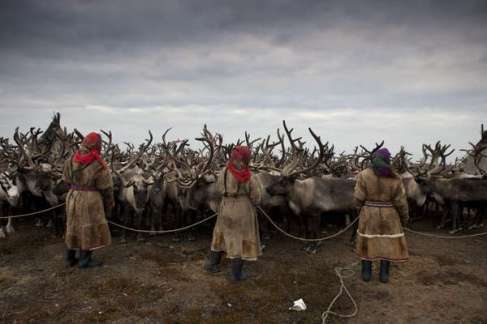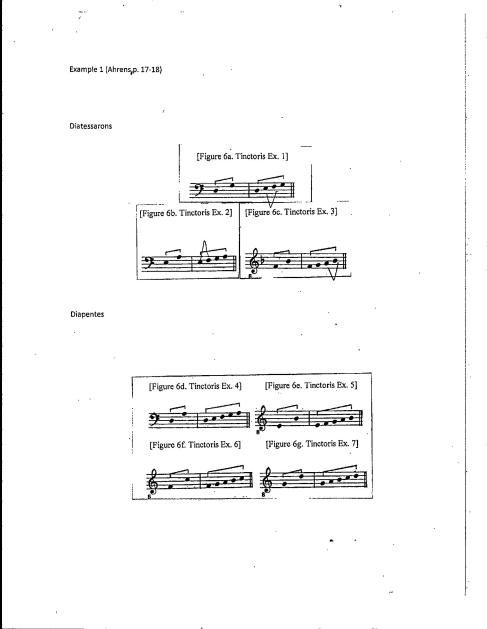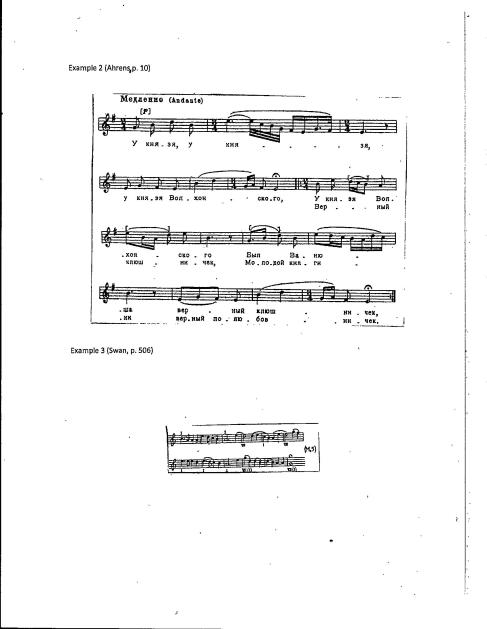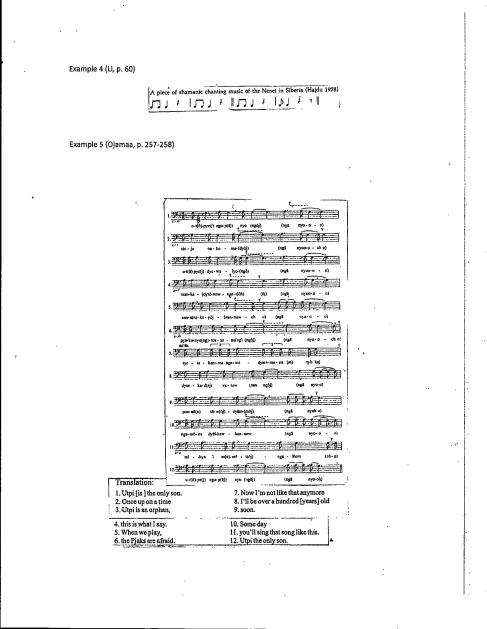Unveiling Theoretical Techniques in Early Russian Music: A Research Paper by Courtney Van Cleef
*DISCLAIMER: I did not include my bibliography nor are my sources cited in this online posting! Although I organized the research in a cohesive manner, the information presented is not all my original work and should be reviewed with educational purposes in mind.
Many scholars will have you believe that the history of Russian Music before Glinka is sparse and ultimately insignificant. It is true that the improvisational nature of the Russian people’s folk music does not lend itself to the extensive documentation that we see in Western Europe. Furthermore, the ban on instrumental music in the Byzantium-style Eastern Orthodox Church in many ways retarded the rapid development of an instrumental body of work that would put Russia on the map. It was not until the 19th century that at last we begin to see the circulation of collected folk songs. Even today, case studies on the music of tribes located around Russia’s vast geography are not easily accessed beyond its borders. Nonetheless, one must recognize the deeply ingrained characteristics in the music of these ancient cultures on the composers that so define the Russian Repertoire. Indeed, the collections of songs compiled by Balakirev, Tchaikovsky, and Stravinsky, not to mention the countless references in music of Soviet composers such as Shostakovich, all owe to a deep respect of the music of the people. This essay aims to explore the theoretical techniques that characterize early Russian music. In order to comprehensibly cover the most important spheres in this genre, we will explore the folk song traditions of western Russia, observe the traditions of the Nenet people as a sample of Siberian traditions, and identify traditions in Russian liturgical music.
The largest a most diverse body of early Russian music is found in folk songs. These include but are of course not limited to byliny (heroic songs written of a type of Russian warrior, known as a bogatyr), historical songs, ritual songs, wedding songs, bytovye songs (written about Russian daily life), and lyrical songs. The songs were a part of everyday life to the peasants and are thus treated with a sort of reverence and seriousness. For example, instrumental accompaniments is simply not present as the Russians associate instruments with “light-hearted revelry” and consider them to be inappropriate in the context of the song. Furthermore, women are the primary vocalists to sing these songs.
Rhythmically, Russian music rarely conforms to a western style formation and thus bar lines serve little purpose. Whereas in a western country, the syncopation of the Bohemians or the rattle of the castanets in the Spanish fandango have become easily identifiable as distinctly belonging to these countries, the closest we come to a “Russian” rhythm lies in a vigorous three accented pattern found in a pliassovyia (dance song). In line with the treatment of songs as serious, it is not surprising that Russian dance songs are not particularly significant to the culture. In classifying the various types of Folk songs, scholar Emily Ahrens also notes the Bytovye as another type of dancing song with strong accents on the final beat and clearly expressed rhythms.
Harmonically, most scholars agree on the Russian folk songs being largely diatonic. In relation to choices of progression by the various voices, music historian Alfred Swan goes so far as to say that non-diatonic half-steps are utterly alien to the peasant vocalist. However, there are multiple arguments as to how exactly the music should be analyzed. Ahrens utilizes the Tinctoris treatise, De Natura et Propretate Tonorum in its discussion of the three types of diatessarons and the four types of diapentes, to explain the various pitches. Example 1 (Example 1) provides a staff representation of the various diatessarons that divide the octave by a fourth and the diapentes that divide the octave by a fifth, conveniently labeling them A-G. Simply put, the diapentes and diatesserons together form the scales observed. If we look at Example 2 (Example 2) we see that all pitches included are E, F#, G, A, B, C, and D range is from E4 to E5. Although the song begins in G and the “key signature” provided by the editor, Tchaikovsky, suggests G major, the fact that the piece ends on E suggests a different tonality. This is consistent with the Russian ideal of “peremennost” (or, mixing of tones) and its consequences stand at the crux of analytical debate. Using the ideas of Ahrens we can build a scale using all pitches by combining Diapentes D and Diatesseron B. This is considered authentic form as the scale divides the octave into a fifth on bottom and a fourth above with the first note of the octave as final and the fifth above the final as dominant.
Swan’s approach to analyzing the folk songs uses the traditional church modes but accounts for the seemingly undulating major and minor tonal centers by speaking about “semi-chromes” where notes of the chromatic scale crop up in the course of the melody, but not successively. He proceeds to choose examples where he finds what he considers to belong to a specific mode, and then comments on distinct Russian treatments of these particular modes. For example (Example 3) in this excerpt we see what appears to be a portion of the song in a natural minor (Aeolian mode). Swan notes the Russian tendency in this particular mode to place emphasis on the VII degree, in effect implying a harmonization by a major chord. True to form, the excerpt ends on a G, and in the preceding measure a G major chord is clearly outlined. This supports Swan’s observation of the VII and its treatment in Aeolian form. Had we used Ahrens’ analysis method, we might have noted instead the G4-G5 range and then have chosen to combine Diapente G and Diatesseron A to account for all notes in the example (Example 1).
Additionally, there are distinctions to be found in the way that voices enter and harmonize. As previously mentioned, the songs were generally performed by women and thus we will often observe a solid middle range of pitches. Often a “precentor” or soloist will begin singing and complete a period of varying lengths. She will then be joined by a mixed choir that will, without fail, enter all at the same time and remain until the end of the song. Consistent with the mistrust of Russians for a regular or predictable beat pattern, the choir may not join the soloist on a strong beat and indeed could enter on what Swan describes to be a passing tone.
One example of a Siberian music tradition is that of the Nenet peoples. Nenets inhabit western Siberia between the Kanin Peninsula in the White Sea and the mouth of the River Yenisev. The population is small, only totaling in approximately 30,000 people, and is divided between the tundra (thus the term “Tundra Nenets”) and the taiga (“Forest Nenets”). The Nenet are largely herders of reindeer and as is common in such cultures their religion centers on rituals enacted by a village Shaman. An example of Shamanism affecting rhythmic tradition is frequent use of a Manchu-like “three-accented pattern” (Example 4), thought to bring good luck and fortune. The hierarchy of the Shaman and the central position males have in Nenet society account for the distinct difference from western Russian music tradition of women leading the songs. This may also account for the low timbre of notes in recorded songs.
Nenet music is circumpolar in style and based on a trinity of singing sound, speech-like sound, and imitative sound. In Nenet music, the meaning of the text is of greatest importance in the song. In an interview with Juri Vella, a forest Nenet from Khanty Mansi Autonomous Region of western Siberia, he specifically notes that a singer may repeat a line that he feels the audience did not understand the first time. The singer will try to provide an explanation in the melody, thus the melody is retained but not in the same way as the first time. This, however, does not account for all rhythmic deviation in a melody. In Example 5 (Example 5) an examination of the text in line 7 does nothing to further explain the previous lines, yet it has a recitative melody and is performed ad libitum. In cases of melodies recited by Shamans as magical formulas, the songs adopt an entirely speech-like sound, imitating speech intonation.
The focus on the text leads to many rhythmic peculiarities, for example the text will often not line up with the melody. To this end, melodies can be placed in two categories. In the first category, a phrase is repeated without change and the melody is considered an equal-length composition. In the second category, the length of the melody changes each time based on the text. Vella comments that at times a message takes up more space than one line, causing the singer to “violate rhythm and speak in a hurry”.
Conversely, the text may be shorter than the melody and thus meaningless syllables are added. In Example 5 (Example 5), Line 2: kogda-to v proshedshchem vremeni nga nej translates to “Once upon a time nga neij” with “nga neij” acting as filler syllables. Meaningless syllables can also be greatly useful in joining 2 lines so that the song is rendered as one uninterrupted sentence. This technique is linked to Shamanistic songs as ritual dictates that interrupted singing can prevent a message from reaching the spirits.
There are also instances where the text continues past the end of one melodic line and into the next. The point of this practice is meant to encourage a sense of continuity. In Example 6 (Example 6), the word wyek-lhaho is broken between lines 1 and 2. A technical practice that supports this call for continuity lies in breathing. Vella comments that Europeans breathe when a line ends, but Nenets breathe at random places so that breathing does not mean anything”. Ojamaa claims this is only part of the truth as there are in fact cases in European art songs where the vocalist breathes in a place other than the end of a sentence, just as there are places where Nenet breathing is not arbitrary.
A final but nonetheless important section of traditional music can be found in that of the Russian Chant and its place in the Eastern Orthodox Church. This genre for a variety of reasons including an archaic notational system also remains the most elusive in terms of proper analysis. As stated by Schidlovsky, one discovers that “what might be called a “theory” of the music has to do primarily with questions of notation”.
Russian Orthodoxy arrived in Constantinople during the reign of Prince Vadimir of Kiev in the 10th century. Its point of origin makes it not surprising that the theory and notation of early chants were strongly influenced by Greek theory. Specifically the middle Byzantine notation classified as the Coislin System was used for notation, characterized by tonal range symbols, strokes, and special black symbols to indicate inflections of the neumes. This Russian kind of neumatic chant was thusly termed znammeny, from the word znamia, meaning sign or neume. The earliest readable chants to be found come from the 12th century. Unlike western chants based on scales, these early manuscripts of Byzantine psalmody and hymnody suggest an organization by a system of eight church modes (echoi) referred to as the Octoechos. The chants appear to be diatonic and unison. In Swan’s example of the liturgical scale (Example 7), we find the pitches F, G, A, B-flat, C, D, E-flat, F, G, A-flat, C. This means that in the lower octave there is a major triad F, A, C and in the upper octave we have a minor triad F, A-flat, C existing within the same scale. Swan’s point is that this is a commonality in folk songs and thus implies a link between the two genres. Unfortunately, the majority of these earliest texts no longer exist, most likely as the result of war and invasion of the tartars.
By the 15th century, a ravaged Kiev had sharply declined as a Russian cultural center and Moscow was on the rise. During the reign of Ivan the Terrible from 1533 to his death in 1584 we begin to finally see manuals called azbuki that explain the neumatic system. Azbuka developed in scope to include not only short verbal descriptions, but also the “razvody”, or explanations of the more complex notation through the use of equivalent, simpler signs. In the early 17th century, Ivan Shaidurov, a west educated monk familiar with Renaissance music of Western Europe, clarified znamenny manuscripts by introducing two improvements. The first of these changes included a codified scale system of the Great Russian Znamenny Chant by firmly establishing the number of pitches in the scale as twelve. He also introduced a system of red marks to accompany the black neumes as an indication of pitch, qualitative and qualitative inflections of the neumes. These red marks create a sort of “ladder”, beginning with a bottom rung of three pitches including Low UT, Low RE, and Low MI, a middle rung of six pitches including UT, RE, MI, FA, SOL, LyA, and a high rung of three pitches including High FA, High SOL, and High LyA. If we give pitch names to these syllables we are left with C-flat, D-flat, E-flat, C, D, E, F, G, A, F-sharp, G-sharp, A-sharp, confirming that the twelve pitches create a complete chromatic scale despite a missing TI (covered by C-flat).
The last significant reforms of the Russian chants appear around the 1660’s under the direction of Patriarch Nikon in his quest to reform the Orthodox Church. A third group of Symbols, Auxiliary Pitch Marks, were added to clarify the pitches with their tonal range signs. Nikolai Diletsky’s Musical Grammar, published in this era, not only helped explain these reformations but also encouraged western style polyphony (including clear tonic-dominant harmonic relationship). The reign of Peter the Great further brought an influx of French, Italian and German influences that obscured the techniques of the Russian tradition. On the subject of church music written during this time, Razumovsky notes that “not one of these works proved to be perfect and edifying in a church sense, because in each work the music predominates over the text, most often not at all expressing its meaning”. In the context of a culture that for hundreds of years did not allow instrumental accompaniment for concern that it takes away from the meaning of the words, this practice is in major conflict with the original traditions.
Uncovering the theory that is so deeply rooted in passed down traditions, compounded by sizable holes in the documentation of the earliest Russian music, is no doubt a challenge for modern scholars. The various collections of songs and the conflicting manner in which their notation is treated is a testament to the unique quality of the Russian song and its ill-fitting nature when explained with the much more easily accessible western theory. For scholars who seek to understand what makes the music of Glinka and beyond distinctly special, it is absolutely necessary and in fact exciting to dig deeper for more knowledge about how the people of Russia structured their own music theory. There is still a copious amount of research to be done, but studies on sub-cultures like the ones conducted of the Nenet people may be the key to finding the answers. Meanwhile, an effort by the Russians themselves to preserve their culture in performance and church keeps the repertoire in sight and encourages more study by musicophiles and musicologists alike. Perhaps in time, we will see a picture clear as that of music theory in Western Europe.






Admittedly, It has been a while since I visited this material; however, I think you are asking how I assigned names to the bottom rung of three pitches including Low UT, Low RE, and Low MI, middle rung of six pitches including UT, RE, MI, FA, SOL, LyA, and a high rung of three pitches including High FA, High SOL, and High LyA. Perhaps you know Ut by it’s more modern name “DO” and Lya by “LA”. I took the solfege syllables provided to me in the research to mean precisely this. I started by assuming UT to be C natural (although I suppose you could assign it any name and it would still work out to be the twelve chromatic pitches with crazy spellings). Low UT (DE in solfege?) would mean a half step below, thus C flat (or B if you are really bothered by the missing ti). If you continue this pattern of assigning names, you get: bottom rung (C-flat, D-flat, E-flat), middle rung (C, D, E, F, G, A), high rung (F-sharp, G-sharp, A-sharp). Let’s reorganize: C-flat, C, D-Flat, D, E-flat, E, F, F-sharp, G, G-sharp, A, A-sharp. Perhaps you are bothered by the mixed spelling, but if you consider enharmonic equivalents it works out to be a neat chromatic scale. It is entirely possible that I am incorrect, but based on the materials I read, this is what I comprehended. Thank you for reading. I hope it has been helpful to you!